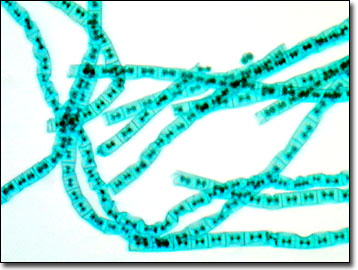Brightfield Digital Image Gallery
Zygnema Green Algae
In the world of filamentous freshwater algae (division Chlorophyta), the genus Zygnema, with its two stellate chloroplasts per cell, is a standout. Found often alongside Spirogyra, another still-water green algal genus, Zygnema species are classified as conjugate algae (phylum Gamophyta) because of their means of sexual reproduction by conjugation.

Forming green or yellow-brown mats of macroscopic threads or filaments, Zygnema can reproduce asexually, sexually, or vegetatively. Akinetes, spore-like bodies with very thick cell walls, are produced when the environment becomes unsuitable, allowing these green algae to withstand droughts and harsh winters via this means of asexual reproduction. Alternatively, in deteriorating conditions, sexual reproduction can commence when two side-by-side filaments grow conjugation tubes toward each other. DNA from each plant moves toward the center of the tube, fuses, and forms a zygospore. The zygospore sinks into the sediments of the still waters, awaiting more favorable habitat conditions before emerging as new filamentous algal strands. Both scalariform and lateral conjugation occurs after zygospore formation. There are many species in the genus, and individual types of Zygnema are distinguishable by the shape, size, and other characteristics of the zygospores they produce.
Fragmentation of Zygnema filaments accounts for vegetative reproduction, particularly when available nitrates and phosphates ("nutrients") are available in sufficient quantities. As with Spirogyra, thick mats and green clouds of Zygnema indicate over-fertilization or "enrichment" of water bodies, often by contaminated stormwater runoff. Large blooms can greatly influence the chemistry of a water body, particularly in microhabitats within the pond, ditch, spring, or vernal pool.
During the day, the hair-like strands of green algae produce relatively large volumes of dissolved oxygen, even raising the dissolved oxygen concentration above the saturation level (supersaturation). At night, as with other green plants, the metabolic processes reverse and the masses of green algae consume oxygen and produce carbon dioxide gas as a cellular respiratory waste product. On cloudy days or at night, the rapid creation of carbon dioxide in the water column can change the pH of the water too rapidly for obligatory aquatic organisms such as fish, resulting in stress, and abnormal behaviors that make them much more susceptible to piscivores. During winter months in temperate regions, particularly under the cover of ice and snow, the algal mats die and decompose, creating a significant biological oxygen demand due to respiring bacteria feeding on the decaying organic plant matter. Severe competition for limited dissolved oxygen resources, particularly in shallow ponds, between the bacteria and the larger aquatic organisms, such as fishes and tadpoles, often results in a phenomenon referred to as "winterkill", a die-off of fish populations that remains largely undiscovered until the following spring.
Contributing Authors
Cynthia D. Kelly, Thomas J. Fellers and Michael W. Davidson - National High Magnetic Field Laboratory, 1800 East Paul Dirac Dr., The Florida State University, Tallahassee, Florida, 32310.
BACK TO THE BRIGHTFIELD IMAGE GALLERY
BACK TO THE DIGITAL IMAGE GALLERIES
Questions or comments? Send us an email.
© 1995-2025 by Michael W. Davidson and The Florida State University. All Rights Reserved. No images, graphics, software, scripts, or applets may be reproduced or used in any manner without permission from the copyright holders. Use of this website means you agree to all of the Legal Terms and Conditions set forth by the owners.
This website is maintained by our
Graphics & Web Programming Team
in collaboration with Optical Microscopy at the
National High Magnetic Field Laboratory.
Last Modification Friday, Nov 13, 2015 at 01:19 PM
Access Count Since September 17, 2002: 27537
Visit the website of our partner in introductory microscopy education:
|
|
